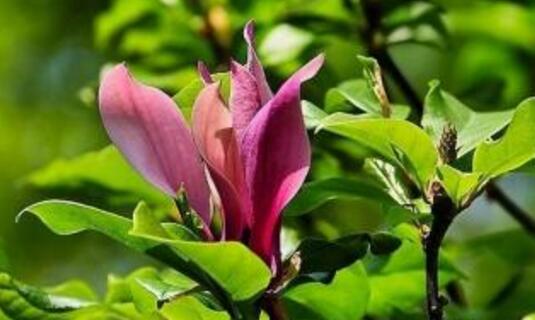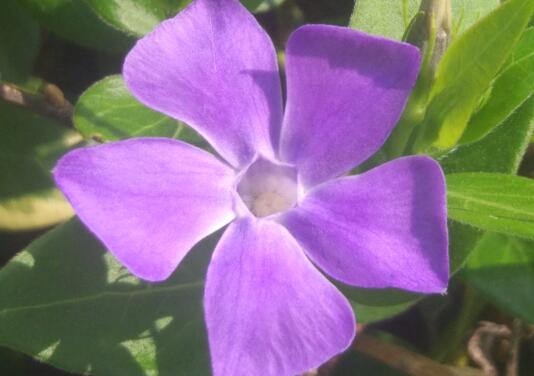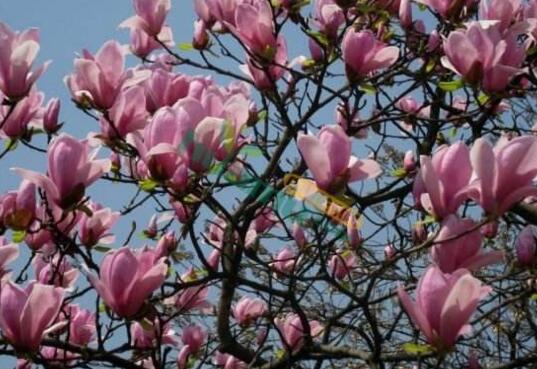How to raise purple magnolia, the breeding methods and matters needing attention / turning basin should be careful.
Purple magnolia flowers large, attractive color, can be said to be very good-looking, so more and more people want to plant it, but if you want to make it bloom smoothly, the premise is that the correct maintenance skills, then how to raise the best purple magnolia? Let's take a look at the cultivation methods and precautions of purple magnolia.
How to raise purple magnolia

Planting any plant should be based on its growth habits to develop the corresponding maintenance skills, then how to raise purple magnolia? We need to understand its characteristics first. Purple magnolia likes warm and humid environment, in temperature, it is more cold-resistant not high temperature; in soil, it likes fertile drainage good acid soil; like fertilizer not drought, afraid of flooding.
Purple Magnolia cultivation methods and precautions
1. Choice of basin
Pots should be slightly deeper to ensure that the growth of plants will not be hindered by the pot wall. Some foam blocks can be placed in the drainage holes of the basin to increase the drainage of the basin bottom.
Note: basin is not easy to choose too large kind, otherwise the use of too much soil will lead to nutrient dispersion, whether watering or fertilization can not be fully absorbed; pad foam do not block the drain hole.
2. Selection of soil
Purple magnolia is not tolerant of salt and alkali, so how to raise purple magnolia in the selected soil? The answer is to use acidic sandy soil, such as rotten leaf soil and vegetable soil, etc., to which 50 grams of bone meal or organic fertilizer can be added.
Note: Purple Magnolia gets nutrients mainly through the soil, so good soil can ensure that Purple Magnolia gets enough nutrients, so we must pay attention to the health of the soil, so as to ensure that Purple Magnolia is free from pests and diseases.
III. Temperature
Purple magnolia is a relatively cold-resistant plant, in time in the north it can also winter outdoors, but when planting, need to be careful not to put it in a higher temperature environment, such as kitchen, heat source and other places.
Note: Although purple magnolia has a strong cold resistance, but it is more afraid of strong winds, so in winter if the wind is large, should pay attention to the protection of purple magnolia, avoid branches or roots damage.
IV. Illumination
Purple Magnolia likes sunlight, and its ability to withstand shade is weak. Although it can grow in a semi-shady environment, it will grow slowly, and it will affect flowering, making the flowers thin and dim in color, and it will not be able to play the role of Purple Magnolia.
Note: When raised indoors, be sure to pay attention to the light is not too weak, such as dark corners or closed environment is not conducive to the growth and development of purple magnolia.
V. Fertilization
The number and color of purple magnolia flowers are closely related to fertilization. Therefore, it is very critical before flowering and within 2 months after flowering. Phosphorus and potassium fertilizer should be applied before flowering to expand flower buds, and after flowering, it can promote purple magnolia to sing more pregnant buds. It can be seen that fertilization is important in the cultivation methods and precautions of purple magnolia.
Note: fertilization should not be excessive, in winter before the phosphorus and potassium can be chased once, can increase the cold resistance of purple magnolia, after which it is necessary to apply less fertilizer.
VI. Watering
Purple magnolia afraid of waterlogging and drought tolerance, so when watering, neither too much nor often do not water, keep the soil moist do not waterlogging, soil dry after watering can be.
Note: When the rainy season arrives, timely drainage and waterlogging prevention are needed to avoid rainwater soaking the roots of Magnolia in the water for a long time.
7. Turn over the basin
Every 1-2 years turn over the pot to change the soil once, can prevent the phenomenon of rotten roots, when changing the soil, need to keep half or one-third of the original old soil, do not remove all the soil.
Note: pot turning is usually selected in April to May, to stagger with flowering, after pot turning purple magnolia will have a period of adaptation period, at this time to pay attention to appropriate watering, can suspend fertilization.
Magnolia how to raise the tube Magnolia crown dense, large shiny leaves, large flowers and fragrance, can be used as street trees, can also be planted in public green space, more suitable for planting in the courtyard to watch, is a rare precious greening tree species With the city greening, beautification work is increasingly valued by people, Magnolia is also more and more loved by the majority of landscape designers, therefore, how to maintain, manage Magnolia is also more and more flower farmers friends concerned.
Magnolia grandiflora also known as lotus magnolia, magnolia is evergreen trees. Originated in southeast North America, like warm and humid climate, China's Yangtze River basin to the Pearl River basin widely cultivated, but also more cold, Beijing, Tianjin south as long as the irrigation conditions can be planted in the open; Sun-loving tree species, seedling stage more tolerant shade; To wet, well-drained acid soil and neutral soil growth is appropriate, mild saline-alkali soil can also grow; Fertile-loving tree species, before flowering in spring should be applied once organic fertilizer, autumn can be deeply ploughed soil, and apply decomposed manure; It has few pests and strong wind resistance.
Breeding usually uses two methods: seeding and grafting. Sowing method: collect seeds in autumn, sow them immediately, or store them in sand until the following spring. Sowing should be dense. Transplant them in the nursery the next year and continue to raise seedlings. It takes about 4 years to raise seedlings before they can be taken out of the nursery. Grafting optional magnolia or magnolia for rootstock, generally in spring with branch grafting method. Transplanting should be carried out in spring, in order to improve the survival rate, seedlings must be with soil mass.
The natural tree shape of this species is elliptically oval and very beautiful. Its hair branch force is low, bud force is poor, do not bear pruning, so pruning should be careful, must not arbitrarily cut branches, so as not to affect the tree shape. In the young tree period, in order to make the central main branch grow well, you can pay attention to removing the lateral buds around the main branch.
Key points of flower culture management in December
December flower culture management points 1, sowing December can be sown in the greenhouse flower species are: great rock tung, asparagus, Clivia, bulb begonia, cyclamen, winter coral, Gerbera, etc.; can be picked outdoors with the sowing or sand storage germination of flowers and trees species are: rose (such as Elizabeth), Tianzhu, rich seeds, holly, firethorn, palm, privet, camphor, small leaf privet, Sapindus mutinous, Heather, spinulosa, etc.
2. The woody ornamental flowers and trees that can be cut in December are: plum blossom (mainly palace powder, green calyx and other varieties); rose (mainly Elizabeth, abundant flower rose, miniature rose and other easy-to-root varieties); red leaf plum, wax plum (with heel cutting), spirea, boxwood, etc. Among them, yellow subsoil is suitable for plum and red leaf plum cuttings, mixed substrate of chaff ash and fine sand 2∶1 is suitable for rose cuttings, and other species can be covered with plastic film for heat preservation and moisture preservation.
In the greenhouse, African violet can be cultured by leaf insertion; combined with pruning, hibiscus, geranium, lotus flower, epiphyllum flower, precious stone flower, stone lotus flower, purslane tree, floor root, longevity flower, golden bud flower, shrimp flower, begonia of all seasons, begonia of bamboo joint, begonia of Rieger, pearl orchid, jasmine, dragon tuzhu, five-color plum, gooseberry, daphne flower, green radish, red banana, etc. can be cut. Use cold room seedbed, still can cuttage breed gardenia, golden heart (Phnom Penh) boxwood, 10 mahonia, hypericum, golden bell, Yingchun, podocarpus, arhat cypress, june snow, pyracantha, silver bud willow, triloba and so on. In addition, can also cut Lingxiao, clove, grape and other branches for sand storage, to be next spring and then cuttage.
3, grafting plum varieties, such as bone red, cinnabar, etc., can be used in December to sow apricot, fruit plum, peach seedlings, such as digging up the rootstock after splitting or cutting, and then planted in a certain plant spacing on the seedbed, buried soil to the grafting site above, or even cover most of the wedding ears, pay attention to watering do not penetrate the joint, cover the film to keep warm, the next spring to wait for scion germination and then remove the covered film. Using the excavated wild rose plants, bud grafting fine varieties of roses; or using the strong branch segments (10 to 12 cm long) of Elizabeth rose varieties, cutting or splitting the scions of fine varieties of roses, and then sowing the grafted Elizabeth ear segments into loose seedbeds. The grafting parts can be buried in sand together, do not penetrate into the joint when watering, cover the plastic film for moisture preservation, remove the covered plastic film after the scion sprouts in the next spring, and cut the binding band of the joint part with a blade after the scion completely survives. In addition, can also be in indoor bagging moisture abdomen red maple.
4, layering in December feasible layering culture of flowers and trees species are: Podocarpus, plum blossom, Camellia, osmanthus, Michelia, flowering crabapple, purple magnolia, snowball, brocade flower, gardenia, Yingchun, golden bell, hydrangea, hemp leaf hydrangea, Qionghua, spray snow, pomegranate and so on.
5. The herbaceous flower species that can be cultured by ramets in December are: onion, dwarf lilyturf, auspicious grass, jade hairpin, purple calyx, safflower sorrel, one-leaf orchid, jian lan, spring orchid, cymbidium, kidney fern, belamcanda, iris, big leaf dwarf lilyturf, ophiophora, evergreen, floor root, Guangdong evergreen. The daughter plants cut from the base of the ramets must be small plants that have grown for three or four months on the mother plant, otherwise the color bands of the daughter plants cut down are easy to disappear, which should be paid special attention to.
The woody ornamental plant species that can be cultured in December are: NanTianZhu, Hypericum, Mahonia, Begonia, Palm Bamboo, Safflower Spiraea, Cygnus, Golden Bell, Yingchun, Jasmine, Pearl Orchid, Magnolia, Gardenia, Sisal, Phoenix Tail Bamboo, Philippine White Bamboo, etc.
6. Harvest seeds The grass flower seeds that can be harvested in December are generally the grass flower species that are transferred to the greenhouse or cold room, such as a string of red, chilianthus, marigold, peacock, cyclamen, clivia, etc. Clivia seeds should be picked and sown.
The woody ornamental plants that can be harvested in December mainly include: rose, wisteria, privet, privet, pyracantha, rich seed, holly, camphor and heather. After treatment, these seeds basically need to be stored in sand for germination. They can only be sown in the next year after the seeds are cracked and white. Under dry storage conditions, they are easy to lose vitality, resulting in failure of sowing and seedling in the next year.
7, transplanting planting in December can be flower beds, flower beds planted herbaceous flower species are: carnation, collard greens, pansy, snapdragon, calendula, daisies and so on. Can also be placed in some pots after the grass, such as daisies, calendula, snapdragon, collard greens, pink, pansy, etc., the next spring can be used to do street display.
Most deciduous greening trees and flowering shrubs can be transplanted and planted in December, such as hibiscus, pomegranate, bauhinia, begonia, wintersweet, plum blossom, white magnolia, purple magnolia, sapindus, lukeweed, acacia, horse chestnut, red-leaf plum, cherry blossom, papaya, magnolia, Lagerstroemia, wisteria vine, Lingxiao, linden tree, mandarin tree, red maple, peach, locust tree, locust tree, etc. Evergreen trees and shrubs should be carefully transplanted in winter: Ligustrum lucidum, Osmanthus fragrans, Palm, Magnolia grandiflora, Cinnamomum camphor, Rhododendron, Holly, etc. When transplanting, the main shoots and large branches should be reduced in intensity, and most of the leaves should be deleted. At the same time, large soil balls should be taken. The trunk should be tied with straw rope to wrap the plastic film. The trunk and large branches should be cut and sealed with wax or wrapped with film to reduce water transpiration. After transplanting, we should spray water on the leaves and trunks frequently to ensure their normal survival.
December can be on the pot of stumps and flowers are: plum, wax plum pile, camellia, tea plum, stick stem begonia, flowering begonia. Put it in the greenhouse, carry on the flower urging treatment, it is expected to bloom during the Spring Festival.
December to potted hyacinth, tulip, red narcissus, etc., continue to put in the shed to urge flowers, can promote its flowering around the Spring Festival.
- Prev

How to raise Catharanthus roseus, how to cultivate Catharanthus roseus and matters needing attention / Control of watering
Catharanthus roseus is a kind of highly ornamental flower, which can be seen in many gardens in our country, and there are also many people raising this plant at home in our country, but there are many places needed in the process of breeding. How to raise Catharanthus roseus? What are the culture methods and matters needing attention of Catharanthus roseus
- Next

How to fertilize Magnolia Magnolia, how to fertilize Magnolia Magnolia / six techniques to make the bud bigger
Although purple magnolia is a fertilizer-loving plant, there are still a lot of things to pay attention to when fertilizing it, such as applying phosphorus and potassium fertilizer instead of nitrogen fertilizer before winter can improve cold resistance, so how to apply fertilizer is the most scientific? Let's take a look at the fertilization method of Magnolia.
Related
- Fuxing push coffee new agricultural production and marketing class: lack of small-scale processing plants
- Jujube rice field leisure farm deep ploughing Yilan for five years to create a space for organic food and play
- Nongyu Farm-A trial of organic papaya for brave women with advanced technology
- Four points for attention in the prevention and control of diseases and insect pests of edible fungi
- How to add nutrient solution to Edible Fungi
- Is there any good way to control edible fungus mites?
- Open Inoculation Technology of Edible Fungi
- Is there any clever way to use fertilizer for edible fungus in winter?
- What agents are used to kill the pathogens of edible fungi in the mushroom shed?
- Rapid drying of Edible Fungi

